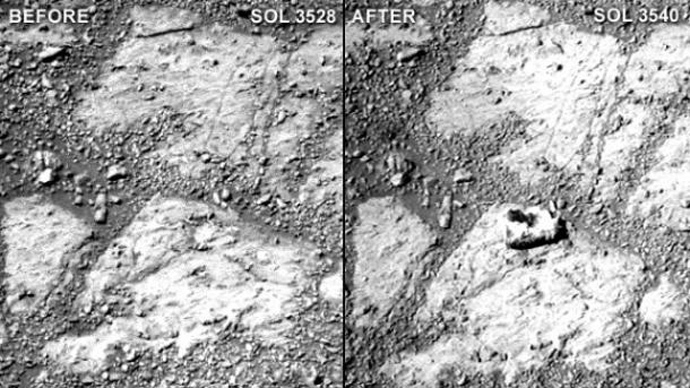Alien life on Mars? NASA lawsuit seeks more information on Red Planet rock

Is it proof of life on Mars, or just a simple rock? An astrobiologist has sued NASA in an effort to compel the space-exploration agency to offer more information on a mysterious stone that appeared on images taken by the Opportunity rover on Jan. 8.
Dr. Rhawn Joseph filed a lawsuit in California this week against NASA and its administrator, Charles Bolden, calling for the agency to "thoroughly scientifically examine and investigate a putative biological organism."
NASA called the object a rock, saying that based on its supposed appearance in “after” photos of the spot but not in a “before” image, it was likely knocked into the rover’s purview by its wheels as it was maneuvering in the area.
White around the outside and red on the inside, NASA scientists have said the rock looks a little like a jelly doughnut. Yet the agency ultimately dubbed the rock “Pinnacle Island.”
"We have looked at it with our microscope. It is clearly a rock," principal rover investigator Dr. Steve Squyres said last week during an event marking the 10th anniversary of Opportunity's mission on Mars. "It appears that it may have flipped itself upside down."
Yet Joseph says this may be a hasty assessment. He believes the object looks like a “mushroom-like fungus, a composite organism consisting of colonies of lichen and cyanobacteria, and which on Earth is known as Apothecium,” he wrote in the filed petition.
He also says the rock was present in the “before” photo NASA released. Joseph posted a magnified version of the earlier photo on Cosmology.com, showing, he maintains, that the object is partially visible. He explains in his petition:
“[S]pores were exposed to moisture due to changing weathering conditions on Mars. Over the next 12 days these spores grew and developed into the structure depicted... The evidence is consistent with biological activity and suggests that life on Mars may have been discovered.
However, in the absence of moisture, biological specimens such as Apothecium will dry out, turn brittle and break apart and this appears to be the condition of the structure as depicted.”
Joseph also criticizes NASA for not releasing more close-up photos. That is, assuming they exist.
“Any intelligent adult, adolescent, child, chimpanzee, monkey, dog, or rodent with even a modicum of curiosity, would approach, investigate and closely examine a bowl-shaped structure which appears just a few feet in front of them when 12 days earlier they hadn't noticed it,” he wrote. “But not NASA and its rover team who have refused to take even a single close-up photo.”
Joseph added that it would be “inexplicable, recklessly negligent, and bizarre” if NASA did not take microscopic, high-resolution photos from a variety of angles.
NASA responded to the suit on Thursday saying it cannot discuss an ongoing legal matter, but that the agency has shared images with the public and is moving forward with research on Pinnacle Island’s composition.
“As we do with all our scientific research missions, NASA will continue to discuss any new data regarding the rock and other images and information as new data becomes available,” agency spokesman Bob Jacobs said in a statement to Popular Science.
Another NASA spokesman emphasized to The Huffington Post that the agency will proceed with caution before making any bold declarations.
"Finding evidence of life on worlds other than Earth is obviously an important goal for NASA," NASA’s Allard Beutel said. "But it has to be definitive evidence."
NASA’s caution, in this case, may not appease those eager for more information on any potential evidence of life on the Red Planet.














